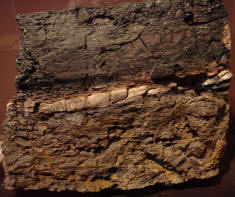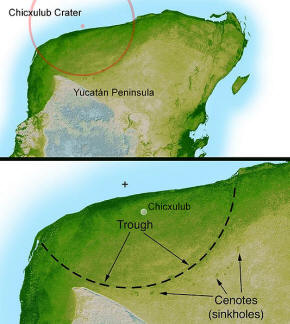Because there were no known fossil non-avian dinosaur
fossils in rocks younger than the K–T boundary,
scientists have concluded that non-avian dinosaurs became extinct immediately before, or
during the event. Recent discoveries of some non-avian dinosaur
fossils above the K-T boundary have been found, indicating that a few
species may have survived for a few hundred thousand years after the K-T
(see
Dinosaur Tombstone).
Scientists theorize that the K–T extinctions were
caused by one or more catastrophic events, such as massive asteroid impacts
(like the
Chicxulub impact), or
increased volcanic activity. Several impact craters and massive volcanic
activity, such as that in the
Deccan traps, have been dated to the
approximate time of the extinction event. These geological events may have
reduced sunlight and hindered photosynthesis, leading to a massive
disruption in Earth's ecology. Other researchers believe the extinction was
more gradual, resulting from slower changes in sea level or climate.
This lesson
will not examine the entire scope of the event. For a more complete
description, see the
K-T Extinction Event page on Wikipedia.
Pterosaurs
Only one family of pterosaurs, Azhdarchidae, was
definitely present at the end of the Cretaceous, and it became extinct at
the K–T boundary. These large pterosaurs were the last representatives of a
declining group that contained 10 families during the mid-Cretaceous.
Smaller pterosaurs became extinct prior to the Maastrichtian during a period
that saw a decline in smaller animal species while larger species became
more prevalent. While this was occurring, modern birds were undergoing
diversification and replacing archaic birds and pterosaur groups, possibly
due to direct competition, or they simply filled empty niches.
Avian Dinosaurs (Birds)
Most paleontologists regard birds as
the only surviving dinosaurs.
However, all non-neornithean
birds became extinct, including flourishing groups like
enantiornithines and
hesperornithiforms.
Several analyses of bird fossils show divergence of species prior to the K–T
boundary, and that duck, chicken and ratite bird relatives coexisted with
non-avian dinosaurs. Neornithine birds survived
the K–T boundary as a result of their abilities to dive, swim, or seek
shelter in water and marshlands. Many species of birds can build burrows, or
nest in tree holes or termite nests, all of which provided shelter from the
environmental effects at the K–T boundary. Long-term survival past the
boundary was assured as a result of filling ecological niches left empty by
extinction of non-avian dinosaurs.
Non-avian Dinosaurs
More has been published about the
extinction of dinosaurs at the K–T boundary than any other group of
organisms. Excluding a few controversial claims, it is agreed that all
non-avian dinosaurs became extinct at the K–T boundary. The dinosaur fossil
record has been interpreted to show both a decline in diversity and no
decline in diversity during the last few million years of the Cretaceous,
and it may be that the quality of the dinosaur fossil record is simply not
good enough to permit researchers to distinguish between the choices.
Since there is no evidence that late Maastrichtian nonavian dinosaurs could
burrow, swim or dive, they were unable to shelter themselves from the worst
parts of any environmental stress that occurred at the K–T boundary. It is
possible that small dinosaurs (other than birds) did survive, but they would
have been deprived of food as both herbivorous dinosaurs would have found
plant material scarce, and carnivores would have quickly found prey to be in
short supply. The growing consensus about the
endothermy of dinosaurs (see
dinosaur physiology)
helps to understand their full extinction in contrast with their close
relatives, the crocodilians. Ectothermic ("cold-blooded") crocodiles have
very limited needs for food (they can survive several months without eating)
while endothermic ("warm-blooded") animals of similar size need much more
food in order to sustain their faster metabolism. Thus, under the
circumstances of food chain disruption previously mentioned, non-avian
dinosaurs died while some crocodiles survived. In this context, the survival
of other endothermic animals, such as some birds and mammals, could be due,
among other reasons, to their smaller needs for food, related to their small
size at the extinction epoch.
Several researchers have stated that
the extinction of dinosaurs was gradual, so that there were
Paleocene dinosaurs.
These arguments are based on discoveries in two rock formations.
First, the discovery of dinosaur remains in the Hell
Creek Formation up to 1.3 metres (4 ft 3 in) above the
K-T boundary indicates some dinosaurs survived at least 40,000 years after
the event. More recent discoveries in the Ojo Alamo Sandstone indicate that
at least one species of hadrosaur lived past the K-T boundary, approximately 65.118 Ma (about
400,000 years after the
K–T event). Some current research claims that these fossils were eroded from
their original locations and then re-buried in much later sediments
(reworked).
Mammals
All major Cretaceous
mammalian lineages, including monotremes (egg-laying mammals),
multituberculates,
marsupials and
placentals,
dryolestoideans, and
gondwanatheres survived
the K–T event, although they suffered losses. In particular, marsupials
largely disappeared from North America and the Asian
deltatheroidans,
primitive relatives of extant marsupials, became extinct.
In the Hell Creek beds of North America, at least half of the ten known
multituberculate species and all eleven marsupial species are not found
above the boundary.
Mammalian species began diversifying
approximately 30 million years prior to the K–T boundary. Diversification of
mammals stalled across the boundary. Current
research indicates that mammals did not explosively diversify across the K–T
boundary, despite the environment niches made available by the extinction of
dinosaurs. Several mammalian orders have been interpreted as
diversifying immediately after the K–T boundary, including Chiroptera (bats) and
Cetartiodactyla (a
diverse group that today includes whales and dolphins and
even-toed ungulates),
although recent research concludes that only marsupial orders diversified
after the K–T boundary.
K–T boundary mammalian species were
generally small, comparable in size to rats; this small size would have
helped them to find shelter in protected environments. In addition, it is
postulated that some early monotremes, marsupials, and placentals were
semiaquatic or burrowing, as there are multiple mammalian lineages with such
habits today. Any burrowing or semiaquatic mammal would have had additional
protection from K–T boundary environmental stresses.
Duration
The length of time taken for the
extinction to occur is a controversial issue, because some theories about
the extinction's causes require a rapid extinction over a relatively short
period (from a few years to a few thousand years) while others require
longer periods. The issue is difficult to resolve because of the
Signor-Lipps effect;
that is, the fossil record is so incomplete that most extinct species
probably died out long after the most recent fossil that has been found.
Scientists have also found very few continuous beds of fossil-bearing rock
which cover a time range from several million years before the K–T
extinction to a few million years after it.
Causes
There have been several theories on
the cause of the K–T boundary which led to the massive extinction. These
theories have centered on either impact events or increased volcanism; some
include elements of both. There is even a scenario combining three major postulated
causes: volcanism,
marine regression, and
extraterrestrial impact.
By
far, the most widely accepted theory is the impact theory. In 1980 a
team of researchers consisting of Nobel prize-winning physicist
Luis Alvarez, his son
geologist Walter Alvarez, and chemists Frank Asaro and Helen Michel
discovered that sedimentary layers found all over the world at the
Cretaceous–Tertiary boundary contain a concentration of
iridium
many times greater than normal (30 times and 130 times background in the two
sections originally studied). Iridium is extremely rare in the earth's
crust, but it is abundant in most asteroids and comets. The Alvarez
team suggested that an asteroid struck the earth at the time of the K–T
boundary. There were other earlier speculations on the possibility of an
impact event, but this was the first evidence uncovered. Such an
impact would have inhibited photosynthesis by generating a dust cloud, which
would block sunlight for a year or less, and by injecting
sulfuric acid
aerosols into the
stratosphere, which
would reduce sunlight reaching the Earth's surface by 10–20%. It would take
at least ten years for those aerosols to dissipate, which would account for
the extinction of plants and
phytoplankton, and of organisms dependent on
them (including predatory animals as well as herbivores). Small creatures
whose food chains were based on
detritus would have a reasonable chance of
survival. The consequences of reentry of ejecta into Earth's atmosphere
would include a brief (hours long) but intense pulse of
infrared radiation, killing exposed
organisms. Global
firestorms may have
resulted from the heat pulse and the fall back to Earth of incendiary
fragments from the blast. High O2
levels during the late Cretaceous would have supported intense combustion.
The level of atmospheric O2
plummeted in the early Tertiary Period. If widespread fires occurred, they
would have increased the CO2
content of the atmosphere and caused a temporary
greenhouse effect once
the dust cloud settled, and this would have exterminated the most vulnerable
organisms that survived the period immediately after the impact.
Subsequent
research identified the Chicxulub Crater buried under
Chicxulub on the coast
of
Yucatán, Mexico as the
impact crater which matched the Alvarez hypothesis dating. Identified in
1990, this crater is oval, with an average diameter of about 180 kilometers
(112 mi), about the size calculated by the Alvarez team.
The shape and location of the crater indicate further causes of devastation
in addition to the dust cloud. The asteroid landed in the ocean and would
have caused
megatsunamis, for which
evidence has been found in several locations in the Caribbean and eastern
United States—marine sand in locations which were then inland, and
vegetation debris and terrestrial rocks in marine sediments dated to the
time of the impact. The asteroid landed in a bed of
gypsum (calcium
sulfate), which would have produced a vast sulfur dioxide
aerosol. This would
have further reduced the sunlight reaching the Earth's surface and then
precipitated as acid rain, killing vegetation, plankton and organisms which
build shells from calcium carbonate For a more in-depth study of the
possible causes, see
Causes of Extinction.
Theological Issues
One of the most frequent questions that comes to mind
concerning extinctions is "Why would God create so many species only to let
them become extinct?" This is a valid question and must be explored.
Although we cannot know what God's thought processes were concerning this
issue, we can come up with some reasonable explanations.
When God created the world, he put in
place the laws which govern nature. If you believe in evolution, then
you believe God started the evolutionary process, and then He let nature run
its course. Thus, it is possible that God simply let nature take its
course. He allowed random events that could cause extinctions, such
as meteor strikes, and high levels of greenhouse gases from massive
volcanism events.
Another possible explanation is that God could have been
directly responsible for the extinctions. This particular extinction
event paved the way for mammals to rule the earth. Without the
extinction of the dinosaurs, life as we know it today would not have been
possible. Mankind, or any other mammal, would have been easy prey for
carnivorous dinosaurs. Mankind's ruling of this world became possible
with the extinction of the dinosaurs.
End
of Reading
Return to the
Old Earth Ministries Online Earth
History Curriculum homepage.

Source:
Dinosaur Extinction

